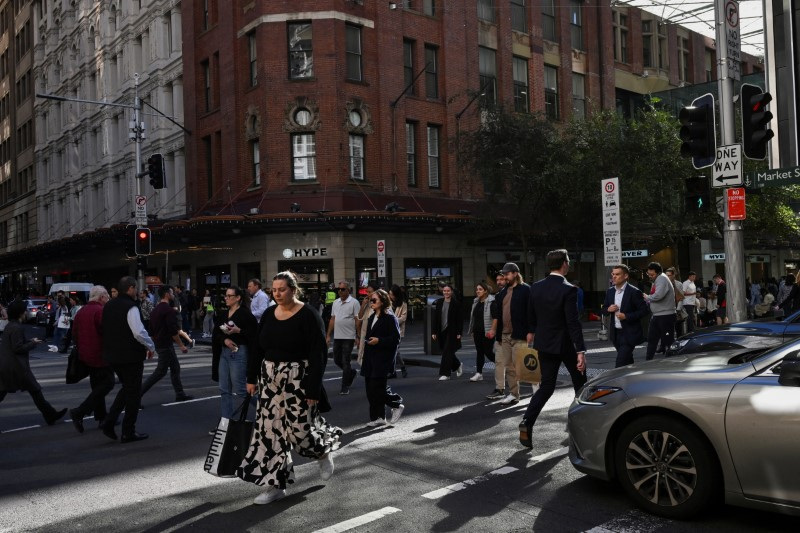By Stella Qiu and Wayne Cole
SYDNEY (Reuters) -Australian employment sped past forecasts in July, yet the jobless rate ticked higher to a 2-1/2 year high as worker participation hit a record in a sign labour demand remains solid despite high borrowing costs.
The strong report supports the Reserve Bank of Australia's assessment that interest rate cuts would be some months off. Markets pared back the chance for an interest rate cut in November to 45%, down from 55% before the release.
The local dollar perked up 0.2% to $0.6610 while three-year bond futures trimmed earlier gains to be flat at 96.51.
Figures from the Australian Bureau of Statistics on Thursday showed net employment rose 58,200 in July from June, when they jumped 52,200. That was well above market forecasts for a 20,000 rise.
Full-time employment surged 60,500, for a third month of strong gains.
The jobless rate, however, ticked up to 4.2%, the highest since early 2022 and above forecasts of 4.1%, but that was due to more people looking for work. The participation rate rose to an all-time high of 67.1%.
"The employment and participation measures remain historically high while unemployment and underemployment measures remain historically low, compared with what we saw before the pandemic," said Kate Lamb, ABS head of labour statistics.
"This suggests the labour market remains quite tight."
The Reserve Bank of Australia has held its policy steady since November, judging the current cash rate of 4.35% - up from the 0.1% during the pandemic - is restrictive enough to bring inflation to its target band of 2-3% while preserving employment gains.
However, it assessed that the labour market was still running a little tight, one reason that underlying inflation, which was at 3.9% last quarter, is only expected to return to the target band by the end of 2025.
Indeed, the July report showed employment rose 3.2% from a year ago, around twice the pre-pandemic average. The workforce rose 82,100 in July with the annual growth at 3.8%.
Even hours worked rebounded for the second month, up 0.4% in July, buckling the recent declining trend.
The RBA has all but ruled out a near-term rate cut. Analysts say it would take a sharp deterioration in the labour market, with falling employment and fast rising jobless rates, for policymakers to cut by Christmas.
Data showed job vacancies continued to fall from elevated levels and wage growth slowed to a one-year low last quarter, although it remained elevated.

"This data flies in the face of our dovish expectations," said Krishna Bhimavarapu, APAC economist at State Street (NYSE:STT) Global Advisors.
"With inflation coming down and the unemployment rate rising, the RBA may be less compelled to consider another hike, but nonetheless may hold the cash rate at 4.35% longer than we expect."